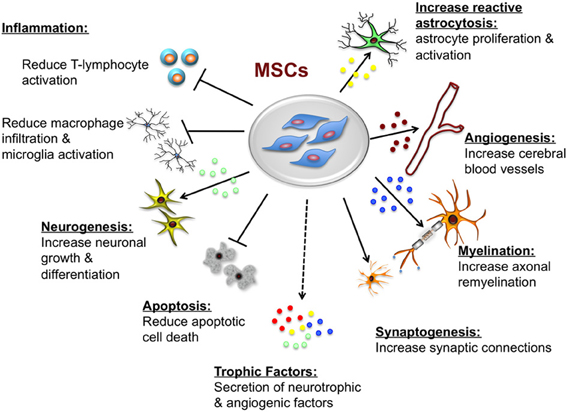Endothelial Progenitor Cells For Injured Tissue Repair
Endothelial Progenitor Cells Role on Injured Tissue
 The endothelial progenitor cells are sourced from the bone marrow and have been found to have the ability to proliferate and differentiate in mature endothelial cells. However, these cells are not only sourced from the bone marrow alone but can also be found in large proportions in non-marrow sources like spleen which particularly has been found to be rich in EPCs. Isolated spleen-derived mononuclear cells, pre-selected with an endothelial cell medium, demonstrated endothelial cell characteristics and formed tubular-like structures. There are hopes that these cells can be used to sufficiently improve re-endothelialization and lessen neointima formation after carotid artery injury. In a trial, intravenous transfusion of spleen-derived EPCs in splenectomized mice showed special homing to the injured area. However, these results were only achieved when the host organ was removed. Thereafter, it was suggested that removal of the spleen prolonged the EPC time in circulation, which may result in a change of surface markers on the cell because of homing signals of the injury site thus favoring recruitment to the ischemic area rather than preferential homing to the organ of origin. With researchers still working to establish the mechanism with which the EPCs repair damaged tissues; there is hope that these cells can be useful in treatment of injured tissues.
The endothelial progenitor cells are sourced from the bone marrow and have been found to have the ability to proliferate and differentiate in mature endothelial cells. However, these cells are not only sourced from the bone marrow alone but can also be found in large proportions in non-marrow sources like spleen which particularly has been found to be rich in EPCs. Isolated spleen-derived mononuclear cells, pre-selected with an endothelial cell medium, demonstrated endothelial cell characteristics and formed tubular-like structures. There are hopes that these cells can be used to sufficiently improve re-endothelialization and lessen neointima formation after carotid artery injury. In a trial, intravenous transfusion of spleen-derived EPCs in splenectomized mice showed special homing to the injured area. However, these results were only achieved when the host organ was removed. Thereafter, it was suggested that removal of the spleen prolonged the EPC time in circulation, which may result in a change of surface markers on the cell because of homing signals of the injury site thus favoring recruitment to the ischemic area rather than preferential homing to the organ of origin. With researchers still working to establish the mechanism with which the EPCs repair damaged tissues; there is hope that these cells can be useful in treatment of injured tissues.
Apart from the crucial role of maintaining the cardiovascular homeostasis that the vascular endothelial cells play, they also provide a physical barrier between the vessel wall and lumen. The endothelium also secretes a number of mediators that regulate platelet aggregation, coagulation, fibrinolysis, and vascular tone. However crucial functions the endothelium plays, it may lose its physiological properties and hence termed endothelial dysfunction. Incase this occurs it will not be able to promote vasodilation, fibrinolysis, and anti-aggregation as it normally does to ensure sound vascular health. Endothelial cells secrete several mediators that can alternatively mediate either vasoconstriction, such as endothelin-1 and thromboxane A2, or vasodilation, such as nitric oxide (NO), prostacyclin, and endothelium-derived hyperpolarizing factor. Nitric oxide is the chief contributor to endothelium-dependent relaxation in conduit arteries; however the contribution of endothelium-derived hyperpolarizing factor predominates in smaller resistance vessels.
Restores endothelial functions
The endothelial progenitor cells are essential as they are immature but with the ability of differentiating into mature endothelial cells and hence may help restore the endothelial functions in case of injuries that may result in endothelial dysfunction. The release of growth factors and cytokines may cause vascular injury and tissue ischemia which will in turn mobilize endothelial progenitor Cells which will specifically home in on the ischemic sites to stimulate compensatory angiogenesis once in the peripheral circulation.
Furthermore, endothelial progenitor cells forms part of a pool of cells able to form a cellular patch at sites of endothelial injury, thus working directly to achieve the homeostasis and repair of the endothelial layer. Endothelial progenitor cells have now been identified to be playing a major role in cardiovascular biology, as a matter of fact, the extent of the circulating EPC pool is now considered a mirror of cardiovascular health. Practically all risk factors for atherosclerosis have been linked to declining population of circulating endothelial progenitor cells or their dysfunction. The increase in population of the circulating endothelial progenitor cells have been linked to decreased cardiovascular mortality.
 One of the common diseases of the cardiovascular is atherosclerosis which is characterized by leucocyte infiltration, smooth muscle cell accumulation, and neointima formation. Basically atherosclerosis is a cardiovascular inflammatory disease. It has been shown that the activation and damage of the endothelial layer is what causes the development of lesions. Recent studies have disputed an earlier notion that the adjacent intact endothelium replaces the damaged endothelial cells. These studies have demonstrated the recruitment and incorporation of vascular progenitor cells into atherosclerotic lesions and thus providing evidence in support of the role of vascular cells in the development of the disease. The incorporation of endothelial progenitor cells into mice showed promising results. In a model of transplant atherosclerosis, regenerated endothelial cells from arterial grafts were found to originate from recipient circulating blood but not the remaining endothelial cells of the donor vessels. It was also found that the endothelial monolayer in a vein graft three days after surgery was completely lost and later replaced by circulating endothelial progenitors.
One of the common diseases of the cardiovascular is atherosclerosis which is characterized by leucocyte infiltration, smooth muscle cell accumulation, and neointima formation. Basically atherosclerosis is a cardiovascular inflammatory disease. It has been shown that the activation and damage of the endothelial layer is what causes the development of lesions. Recent studies have disputed an earlier notion that the adjacent intact endothelium replaces the damaged endothelial cells. These studies have demonstrated the recruitment and incorporation of vascular progenitor cells into atherosclerotic lesions and thus providing evidence in support of the role of vascular cells in the development of the disease. The incorporation of endothelial progenitor cells into mice showed promising results. In a model of transplant atherosclerosis, regenerated endothelial cells from arterial grafts were found to originate from recipient circulating blood but not the remaining endothelial cells of the donor vessels. It was also found that the endothelial monolayer in a vein graft three days after surgery was completely lost and later replaced by circulating endothelial progenitors.
The endothelial progenitor cells are able to mediate vascular repair and attenuate the progression of this disease even when there is a continued vascular injury. treatment of chronic injuries have been done with endothelial progenitor cells in mice in trials , however the mechanism involved is still a mystery but it is clear that these EPCs contribute a big deal to the restoration of the injured endothelial layer. In one example, intravenous infusion of spleen-derived mononuclear cells increases endothelium-dependent vasodilatation in atherosclerotic mice, signifying that progenitor cells play an important role in repairing the vascular injury.
Finally, for more information about bone marrow transplant and stem cell transplantation, visit www.awaremednetwork.com. Dr. Dalal Akoury has been practicing integrative medicine for years; she will be able to help. You can also visit http://www.integrativeaddiction2015.com and learn more about the upcoming Integrative Addiction Conference 2015. The conference will deliver unique approaches to telling symptoms of addiction and how to assist patients of addiction.
Endothelial Progenitor Cells Role on Injured Tissue







 The most important structure that plays the role of a link between the body and the brain is the
The most important structure that plays the role of a link between the body and the brain is the  Transplantation of cells replaces the damaged neural tissues and restores function after spinal cord injury. Successful results have been obtained with different cell types including adult neural
Transplantation of cells replaces the damaged neural tissues and restores function after spinal cord injury. Successful results have been obtained with different cell types including adult neural 





 The benefits of light are many but to most people exposure to sunlight has only one benefit associated with vitamin D. however there is much worse views that have been propagated in relation to exposure to sunlight and while the fact that the
The benefits of light are many but to most people exposure to sunlight has only one benefit associated with vitamin D. however there is much worse views that have been propagated in relation to exposure to sunlight and while the fact that the  Normally, during the treatment the patient will sit in front of a light box for thirty minutes a day during the season when light is inadequate. The treatment works best when the patient goes for it immediately after waking up. The patient can read, write or eat when sited before the light but it is advisable for the patient to stop looking directly at the light box. Light therapy is believed to work by its effect on brain chemicals that play a role in regulating mood. This treatment can relieve symptoms within a few days, but sometimes takes as long as two weeks or more.
Normally, during the treatment the patient will sit in front of a light box for thirty minutes a day during the season when light is inadequate. The treatment works best when the patient goes for it immediately after waking up. The patient can read, write or eat when sited before the light but it is advisable for the patient to stop looking directly at the light box. Light therapy is believed to work by its effect on brain chemicals that play a role in regulating mood. This treatment can relieve symptoms within a few days, but sometimes takes as long as two weeks or more.







 In a research study done at School of Medicine,
In a research study done at School of Medicine, 




